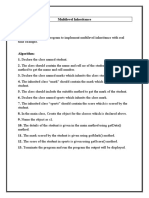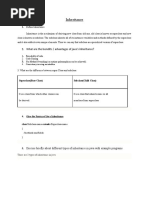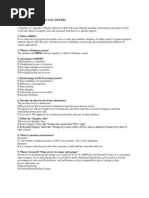Java
Uploaded by
nw887059Java
Uploaded by
nw887059MSBTE Solution App
Micro project
On
“Calculate Area Of Any Type Of Shape Using Abstract Class.”
Submitted By
Sneha Ohol (17)
Madhura Pansare (19)
P
Guided By:
AP
Ms. S.Boharpi
n
Diploma Course in Computer Technology
tio
(As per directives of I Scheme, MSBTE)
lu
So
T E
SB
M
Sinhgad Institutes
Sinhgad Technical Education Society’s
SOU.VENUTAI CHAVAN POLYTECHNIC
PUNE - 411041
ACADEMIC YEAR 2020-2021
Downloaded From MSBTE Solution App
MSBTE Solution App
Maharashtra State Board of
Technical Education
Certificate
P
AP
This is to certify that Ms.Sneha Ohol with Roll No. 17 of Semester IV of
n
Diploma in Computer Technology of Institute Sou. Venutai Chavan
tio
Polytechnic (Code: 0040) has successfully completed the Micro-Project in
lu
Java Programming (22412) for the academic year 2020-2021 as prescribed in
So
the curriculum.
T E
Place: SVCP, Pune Enrollment No:
SB
Date: 10-06-2021 Exam Seat No:
M
Ms.S. Boharpi Mrs.A.V.Kurkute Dr.(Mrs.) M.S. Jadhav
Subject Teacher HOD Principal
Downloaded From MSBTE Solution App
MSBTE Solution App
Maharashtra State Board of
Technical Education
Certificate
P
AP
This is to certify that Ms.Madhura Pansare with Roll No. 19 of Semester IV
n
of Diploma in Computer Technology of Institute Sou. Venutai Chavan
tio
Polytechnic (Code: 0040) has successfully completed the Micro-Project in
lu
Java Programming (22412) for the academic year 2020-2021 as prescribed in
So
the curriculum.
T E
Place: SVCP, Pune Enrollment No:
SB
Date: 10-06-2021 Exam Seat No:
M
Ms.S. Boharpi Mrs.A.V.Kurkute Dr.(Mrs.) M.S. Jadhav
Subject Teacher HOD Principal
Downloaded From MSBTE Solution App
MSBTE Solution App
INDEX
SR NO CONTENTS PAGE NO
1 Aim of the Micro-Project 1
2 Rationale 3
3 Course Outcomes Achieved 3
4 Literature Review 4
5 Actual Methodology Followed 4
6 Actual Resources Used 5
P
7 Skills Developed 7
AP
8 Applications of Micro Project 7
n
tio
lu
So
T E
SB
M
Downloaded From MSBTE Solution App
MSBTE Solution App
Java Programming - 22412 Calculate Area Of Any Type Of Shape Using Abstract Class.
Annexure - I
A Micro-Project Proposal
1.0 Aim of the Micro-Project:
Program To Calculate Area Of Any Type Of Shape Using Abstract Class.
2.0 Intended Course Outcomes:
a) Develop programs using Object-Oriented methodology in Java.
P
AP
3.0. Proposed methodology:
I. Study the concept of JAVA programming.
n
tio
II. Study various syntax and functions of JAVA.
lu
III. Study to create small programs using JAVA.
So
IV. Make program for given criteria.
V. Prepare the final report.
T E
SB
M
Downloaded From MSBTE Solution App
MSBTE Solution App
Java Programming - 22412 Calculate Area Of Any Type Of Shape Using Abstract Class.
4.0 Action Plan:
Name of
Sr. Planned Planned
Details of Activity responsible
No. Start Date Finish Date
Team members
Identify the requirements of the
1 19/04/2021 27/04/2021 Madhura Pansare
project.
2 Design the structure of the project. 29/04/2021 07/05/2021 Sneha Ohol
Develop the program using in
3 10/05/2021 20/05/2021 Sneha Ohol
JAVA.
Debug code and eliminate errors
P
4 26/05/2021 04/06/2021 Madhura Pansare
occurred.
AP
5 Test the project. 07/06/2021 14/06/2021 Sneha Ohol
6 Prepare the final report.
n
15/06/2021 19/06/2021 Madhura Pansare
tio
lu
5.0 Resources Required:
So
S. No. Resources required Specifications
E
1 Computer system Intel(R) Pentium CPU, RAM 4 GB
T
2 Operating System Windows 10, 64 Bit Operating System
SB
3 Software’s Java JDK 15.02, Notepad++
M
6.0 Team members:
S. No. Roll. Number Name of Student
1 17 Sneha Ohol
2 19 Madhura Pansare
Downloaded From MSBTE Solution App
MSBTE Solution App
Java Programming - 22412 Calculate Area Of Any Type Of Shape Using Abstract Class.
Annexure - II
Micro-Project Report
1.0 Rationale:
Abstraction in JAVA shows only the essential attributes and hides unnecessary details
of the object from the user. In Java, abstraction is accomplished using Abstract class,
Abstract methods, and Interfaces. Abstraction helps in reducing programming
complexity and effort.
ABSTRACT CLASS is a type of class in Java, that declare one or more abstract
methods. These classes can have abstract methods as well as concrete methods. A normal
P
class cannot have abstract methods. An abstract class is a class that contains at least one
AP
abstract method.
. n
2.0 Aim of the Micro-Project:
tio
lu
Program To Calculate Area Of Any Type Of Shape Using Abstract Class.
So
3.0 Course Outcomes Achieved
T E
a) Develop programs using Object-Oriented methodology in Java.
SB
M
Downloaded From MSBTE Solution App
MSBTE Solution App
Java Programming - 22412 Calculate Area Of Any Type Of Shape Using Abstract Class.
4.0 Literature Review:
i. An abstract class may also have concrete (complete) methods.
ii. For design purpose, a class can be declared abstract even if it does not contain any abstract
methods:
iii. Reference of an abstract class can point to objects of its sub-classes thereby achieving run-
time polymorphism Ex: Shape obj = new Rectangle();
iv. A class must be compulsorily labelled abstract, if it has one or more abstract methods.
Advantages of Abstraction:
i. Abstract class in Java is highly beneficial in writing shorter codes.
ii. Abstraction in Java avoids code duplication.
iii. Abstract classes enable code reusability.
P
iv. Changes to internal code implementation are done without affecting classes.
Rules For Abstract Class in Java are as follows:
AP
n
tio
lu
So
T E
SB
M
Downloaded From MSBTE Solution App
MSBTE Solution App
Java Programming - 22412 Calculate Area Of Any Type Of Shape Using Abstract Class.
5.0 Actual Methodology Followed:
i. Study the concept of JAVA programming.
ii. Study various syntaxes and functions of JAVA.
iii. Study to create small programs using JAVA.
iv. Study to use Abstraction in JAVA.
v. Make program for given criteria.
vi. Prepare final report.
P
6.0 Actual Resources Used:
AP
S. No. Resources required Specifications
1 Computer system
n
Intel(R) Pentium CPU, RAM 4 GB
tio
2 Operating System Windows 10, 64 Bit Operating System
lu
3 Software’s Java JDK 15.02, Notepad++
So
E
7.0 Source code of program:
T
SB
import java.lang.Math;
M
abstract class Shape
{
abstract void area();
double area;
}
class Triangle extends Shape
{
double b=50,h=15;
void area()
{
area = (b*h)/2;
System.out.println("area of Triangle -->"+area);
}
}
Downloaded From MSBTE Solution App
MSBTE Solution App
Java Programming - 22412 Calculate Area Of Any Type Of Shape Using Abstract Class.
class Rectangle extends Shape
{
double w=70,h=20;
void area()
{
area = w*h;
System.out.println("area of Rectangle -->"+area);
}
}
class Circle extends Shape
{
double r=5;
void area()
{
area = Math.PI * r * r;
System.out.println("area of Circle -->"+area);
P
}
AP
}
class Area
{
public static void main(String [] args)
n
tio
{
Triangle t= new Triangle();
lu
Rectangle r =new Rectangle();
So
Circle c =new Circle();
t.area();
E
r.area();
c.area();
T
}
SB
8.0 Output:
M
Downloaded From MSBTE Solution App
MSBTE Solution App
Java Programming - 22412 Calculate Area Of Any Type Of Shape Using Abstract Class.
9.0 Skills Developed:
During the course of this micro-project, we learnt to create a program on area of
shapes using abstract class.
a) We learnt various syntaxes of Java language.
b) We learnt to create area of shape through abstract class.
c) We also learnt abstraction of a Class.
10.0 Applications of this Micro-project:
P
This micro-project finds its application in:
AP
Abstraction in JAVA shows only the essential attributes and hides unnecessary details
of the object from the user. In Java, abstraction is accomplished using Abstract class,
Abstract methods, and Interfaces. Abstraction helps in reducing programming
n
complexity and effort.
tio
lu
11.0 Area of future Improvement:
So
For future, in a project specially for larger projects and many class files in a abstract
class can be created for different uses like in a main file for importing arithmetic
E
operations, classes can be created named arithmetic_operations in which different
T
class file for different operations like addition, subtraction, multiplication etc. can be
SB
created and for string operations package named string_operation can be developed for
operations like reversing, finding length, concatenating etc. can be made.
M
12.0 Conclusion:
We learn to calculate area of various shape. Also, we developed a java file and learnt
various syntax in java.
Downloaded From MSBTE Solution App
You might also like
- Guide To Clear Java Developer Interview Free Sample100% (1)Guide To Clear Java Developer Interview Free Sample41 pages
- ITE-6102-2013T (UGRD) Computer Programming 1: Quiz 1 To Finals91% (11)ITE-6102-2013T (UGRD) Computer Programming 1: Quiz 1 To Finals25 pages
- "Calculate Area of Any Type of Shape Using Abstract Class.": Sneha Ohol (17) Madhura PansareNo ratings yet"Calculate Area of Any Type of Shape Using Abstract Class.": Sneha Ohol (17) Madhura Pansare11 pages
- Abstract Method in Class: Prof. Kumar Anand SinghNo ratings yetAbstract Method in Class: Prof. Kumar Anand Singh8 pages
- Create Class Shape Different Shapes Will Be Square, Circle, Rectangle... Use Upcasting and Downcasting and Find Area of The Shape SolNo ratings yetCreate Class Shape Different Shapes Will Be Square, Circle, Rectangle... Use Upcasting and Downcasting and Find Area of The Shape Sol2 pages
- Practical No: 1: 1904313902 Avinash Chandravansi 1No ratings yetPractical No: 1: 1904313902 Avinash Chandravansi 139 pages
- L202026100117 - Albert Richard Halim - 20211115No ratings yetL202026100117 - Albert Richard Halim - 2021111512 pages
- Object Oriented Programing: Name System Id Instuctor Program SectionNo ratings yetObject Oriented Programing: Name System Id Instuctor Program Section6 pages
- Abstraction in Java: Interfaces Abstract ClassesNo ratings yetAbstraction in Java: Interfaces Abstract Classes11 pages
- Chart Displaying Volume of Irregular Shapes Using Concept of IntegrationNo ratings yetChart Displaying Volume of Irregular Shapes Using Concept of Integration2 pages
- DATE 7/6/21: Object Oriented Programming (Abstract Classes, Upcasting, Downcasting)No ratings yetDATE 7/6/21: Object Oriented Programming (Abstract Classes, Upcasting, Downcasting)8 pages
- Java Inheritance. Possible Questions and AnswersNo ratings yetJava Inheritance. Possible Questions and Answers8 pages
- Like Classes, They Introduce Types. Why Use Them? ..No ratings yetLike Classes, They Introduce Types. Why Use Them? ..16 pages
- Fundamentals of Software Engineering: Designed to provide an insight into the software engineering conceptsFrom EverandFundamentals of Software Engineering: Designed to provide an insight into the software engineering conceptsNo ratings yet
- All Basic Principles and Concept of DatabasesNo ratings yetAll Basic Principles and Concept of Databases83 pages
- Get Systematic Program Design From Clarity To Efficiency 1st Edition Yanhong Annie Liu PDF Ebook With Full Chapters Now100% (2)Get Systematic Program Design From Clarity To Efficiency 1st Edition Yanhong Annie Liu PDF Ebook With Full Chapters Now84 pages
- Jatin Arora - Grokking The Java InterviewNo ratings yetJatin Arora - Grokking The Java Interview618 pages
- C4CAM: A Compiler For CAM-based In-Memory Accelerators: Hamid Farzaneh João Paulo C. de Lima Mengyuan LiNo ratings yetC4CAM: A Compiler For CAM-based In-Memory Accelerators: Hamid Farzaneh João Paulo C. de Lima Mengyuan Li10 pages
- Software Architecture in Practice: Chapter 2: What Is Software Architecture? Why Is It Important?No ratings yetSoftware Architecture in Practice: Chapter 2: What Is Software Architecture? Why Is It Important?48 pages
- Programming Logic and Design: Seventh EditionNo ratings yetProgramming Logic and Design: Seventh Edition45 pages
- Complete Download What Algorithms Want Imagination in the Age of Computing 1st Edition Ed Finn PDF All Chapters100% (2)Complete Download What Algorithms Want Imagination in the Age of Computing 1st Edition Ed Finn PDF All Chapters61 pages
- Programming in Java: Abstract Class and InterfaceNo ratings yetProgramming in Java: Abstract Class and Interface23 pages
- DCIT 201 Programming I: Session 1 - Fundamental Concepts of OOD and OOPNo ratings yetDCIT 201 Programming I: Session 1 - Fundamental Concepts of OOD and OOP35 pages
- Guide To Clear Java Developer Interview Free SampleGuide To Clear Java Developer Interview Free Sample
- ITE-6102-2013T (UGRD) Computer Programming 1: Quiz 1 To FinalsITE-6102-2013T (UGRD) Computer Programming 1: Quiz 1 To Finals
- "Calculate Area of Any Type of Shape Using Abstract Class.": Sneha Ohol (17) Madhura Pansare"Calculate Area of Any Type of Shape Using Abstract Class.": Sneha Ohol (17) Madhura Pansare
- Create Class Shape Different Shapes Will Be Square, Circle, Rectangle... Use Upcasting and Downcasting and Find Area of The Shape SolCreate Class Shape Different Shapes Will Be Square, Circle, Rectangle... Use Upcasting and Downcasting and Find Area of The Shape Sol
- Practical No: 1: 1904313902 Avinash Chandravansi 1Practical No: 1: 1904313902 Avinash Chandravansi 1
- Object Oriented Programing: Name System Id Instuctor Program SectionObject Oriented Programing: Name System Id Instuctor Program Section
- Chart Displaying Volume of Irregular Shapes Using Concept of IntegrationChart Displaying Volume of Irregular Shapes Using Concept of Integration
- DATE 7/6/21: Object Oriented Programming (Abstract Classes, Upcasting, Downcasting)DATE 7/6/21: Object Oriented Programming (Abstract Classes, Upcasting, Downcasting)
- Like Classes, They Introduce Types. Why Use Them? ..Like Classes, They Introduce Types. Why Use Them? ..
- Fundamentals of Software Engineering: Designed to provide an insight into the software engineering conceptsFrom EverandFundamentals of Software Engineering: Designed to provide an insight into the software engineering concepts
- Get Systematic Program Design From Clarity To Efficiency 1st Edition Yanhong Annie Liu PDF Ebook With Full Chapters NowGet Systematic Program Design From Clarity To Efficiency 1st Edition Yanhong Annie Liu PDF Ebook With Full Chapters Now
- C4CAM: A Compiler For CAM-based In-Memory Accelerators: Hamid Farzaneh João Paulo C. de Lima Mengyuan LiC4CAM: A Compiler For CAM-based In-Memory Accelerators: Hamid Farzaneh João Paulo C. de Lima Mengyuan Li
- Software Architecture in Practice: Chapter 2: What Is Software Architecture? Why Is It Important?Software Architecture in Practice: Chapter 2: What Is Software Architecture? Why Is It Important?
- Complete Download What Algorithms Want Imagination in the Age of Computing 1st Edition Ed Finn PDF All ChaptersComplete Download What Algorithms Want Imagination in the Age of Computing 1st Edition Ed Finn PDF All Chapters
- DCIT 201 Programming I: Session 1 - Fundamental Concepts of OOD and OOPDCIT 201 Programming I: Session 1 - Fundamental Concepts of OOD and OOP





























































































